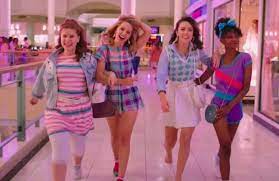The Iconic 1980s Fashion Trends
The 1980s was a decade of bold fashion statements, vibrant colours, and unique styles that continue to influence the fashion industry today. From power dressing to punk rock, the 1980s saw a diverse range of trends that reflected the dynamic spirit of the era.
Power Dressing
One of the most iconic trends of the 1980s was power dressing. Characterised by sharp tailoring, padded shoulders, and bold silhouettes, power dressing was all about exuding confidence and authority in the workplace. Women embraced oversized blazers and shoulder pads, while men favoured tailored suits with wide lapels.
Punk Rock
Punk rock fashion also made a significant impact in the 1980s. Inspired by rebellious subcultures, punk fashion featured leather jackets, ripped jeans, band t-shirts, and edgy accessories like studded belts and combat boots. The DIY ethos of punk rock encouraged individuals to express their creativity through unconventional styling.
Neon Brights
The 1980s were known for their love of neon bright colours. From fluorescent pinks and greens to electric blues and yellows, neon hues dominated fashion trends during this vibrant decade. Whether it was neon leggings, crop tops, or accessories, wearing bright colours was a surefire way to make a statement.
Athleisure
The rise of athleisure in the 1980s blurred the lines between activewear and everyday clothing. Tracksuits, sweatbands, and trainers became fashionable staples for both casual outings and workouts. The comfort and versatility of athleisure wear appealed to a wide audience seeking practical yet stylish attire.
Accessorising Extravaganza
Accessories played a crucial role in defining 1980s fashion. Oversized earrings, chunky jewellery, scrunchies, fanny packs, and statement sunglasses were just some of the must-have accessories that completed outfits during this era. Mixing and matching bold accessories was key to achieving an authentic ’80s look.
In conclusion, the fashion trends of the 1980s were diverse, daring, and unforgettable. Whether you’re drawn to power dressing or punk rock vibes, there’s no denying that the ’80s left an indelible mark on fashion history. Embrace the spirit of this iconic decade by incorporating elements of ’80s style into your wardrobe today!
Embracing the Flamboyance: Five Enduring Qualities of 1980s Fashion
- 1. Bold and Vibrant
- 2. Iconic Trends
- 3. Creative Expression
- 4. Versatile Accessories
- 5. Influence on Modern Fashion
Four Drawbacks of 1980s Fashion: From Disproportionate Silhouettes to Overpowering Accessories
- Excessive shoulder padding in clothing could lead to an unflattering and disproportionate silhouette.
- The neon bright colours popular in 1980s fashion could be overwhelming and challenging to coordinate with other wardrobe pieces.
- Punk rock-inspired fashion trends often involved distressed clothing, which may not appeal to those who prefer more polished looks.
- The emphasis on oversized accessories in 1980s fashion could sometimes overpower an outfit and detract from the overall aesthetic.
1. Bold and Vibrant
One of the standout pros of 1980s fashion was its bold and vibrant aesthetic. Embracing a kaleidoscope of colours and eye-catching patterns, ’80s fashion injected a sense of excitement and energy into outfits. From neon brights to daring prints, the era encouraged individuals to make a statement with their clothing choices, creating a dynamic and expressive style that continues to inspire contemporary fashion trends.
2. Iconic Trends
The 1980s brought forth a wave of iconic trends that have stood the test of time and continue to shape modern style. From the authoritative allure of power dressing to the rebellious edge of punk rock fashion, and the vibrant energy of neon brights, these trends from the ’80s have left an indelible mark on the fashion landscape. Embracing bold silhouettes, edgy ensembles, and eye-catching hues, these iconic trends showcase the creativity and individuality that defined 1980s fashion and still resonate with contemporary fashion enthusiasts today.
3. Creative Expression
During the 1980s, one major advantage of the fashion trends was the opportunity for creative expression. The wide variety of styles available during this era empowered individuals to showcase their unique personalities and artistic flair through their fashion choices. Whether it was experimenting with bold colours, mixing and matching different textures, or embracing unconventional silhouettes, the 1980s provided a platform for people to express themselves creatively and boldly through their clothing. This freedom of expression not only fostered individuality but also contributed to the vibrant and dynamic fashion landscape of the decade.
4. Versatile Accessories
A notable pro of 1980s fashion was the emphasis on versatile accessories. Accessorising played a pivotal role in defining ’80s style, with oversized earrings, chunky jewellery, and statement sunglasses serving as key elements that added flair and personality to outfits. The trend of bold accessories allowed individuals to express their creativity and individuality, making it easy to elevate any look with a touch of ’80s-inspired charm.
5. Influence on Modern Fashion
The enduring pro of 1980s fashion lies in its influence on modern fashion trends. The resurgence of many elements from the ’80s era in contemporary styles highlights the lasting impact and relevance of this iconic period on the ever-evolving world of fashion. From power dressing to neon bright colours, the revival of 1980s fashion cues in today’s clothing choices demonstrates a timeless appeal that continues to inspire designers and fashion enthusiasts alike.
Excessive shoulder padding in clothing could lead to an unflattering and disproportionate silhouette.
During the 1980s, a notable con of fashion was the trend of excessive shoulder padding in clothing, which could often result in an unflattering and disproportionate silhouette. The exaggerated padding, commonly found in blazers, jackets, and dresses, created a broad-shouldered look that sometimes overwhelmed the natural shape of the body. While shoulder pads were intended to convey power and authority through structured tailoring, their excessive use could lead to a bulky and imbalanced appearance, detracting from the overall elegance of an outfit. This trend highlighted the importance of balance and proportion in fashion design, serving as a cautionary tale against going overboard with certain style elements.
The neon bright colours popular in 1980s fashion could be overwhelming and challenging to coordinate with other wardrobe pieces.
The neon bright colours that were popular in 1980s fashion presented a significant challenge for many individuals due to their overwhelming nature and the difficulty of coordinating them with other wardrobe pieces. The vibrant fluorescent pinks, greens, blues, and yellows often clashed with more subdued or neutral tones, making it tricky to create cohesive and balanced outfits. The boldness of neon hues demanded careful consideration and styling expertise to avoid an overly chaotic or mismatched look, requiring fashion enthusiasts to navigate the fine line between making a statement and maintaining sartorial harmony.
Punk rock-inspired fashion trends often involved distressed clothing, which may not appeal to those who prefer more polished looks.
One notable drawback of 1980s fashion inspired by punk rock is the prevalence of distressed clothing. This trend, characterized by ripped jeans, tattered t-shirts, and worn-in leather jackets, may not resonate with individuals who favour more polished and pristine aesthetics in their wardrobe choices. The deliberate use of distressed elements in punk rock fashion can be perceived as unkempt or too casual for those seeking a refined and sophisticated style.
The emphasis on oversized accessories in 1980s fashion could sometimes overpower an outfit and detract from the overall aesthetic.
In the realm of 1980s fashion, one notable drawback was the tendency to go overboard with oversized accessories. While bold statement pieces were a defining feature of the era, there was a risk that these larger-than-life accessories could overpower an outfit and detract from its overall aesthetic. Whether it was chunky jewellery, massive shoulder pads, or exaggerated belts, the emphasis on size sometimes veered into excess, potentially overshadowing the carefully curated elements of an ensemble and diminishing its intended impact. Striking a balance between statement pieces and cohesive styling became a delicate art in navigating the exuberant landscape of 1980s fashion.

